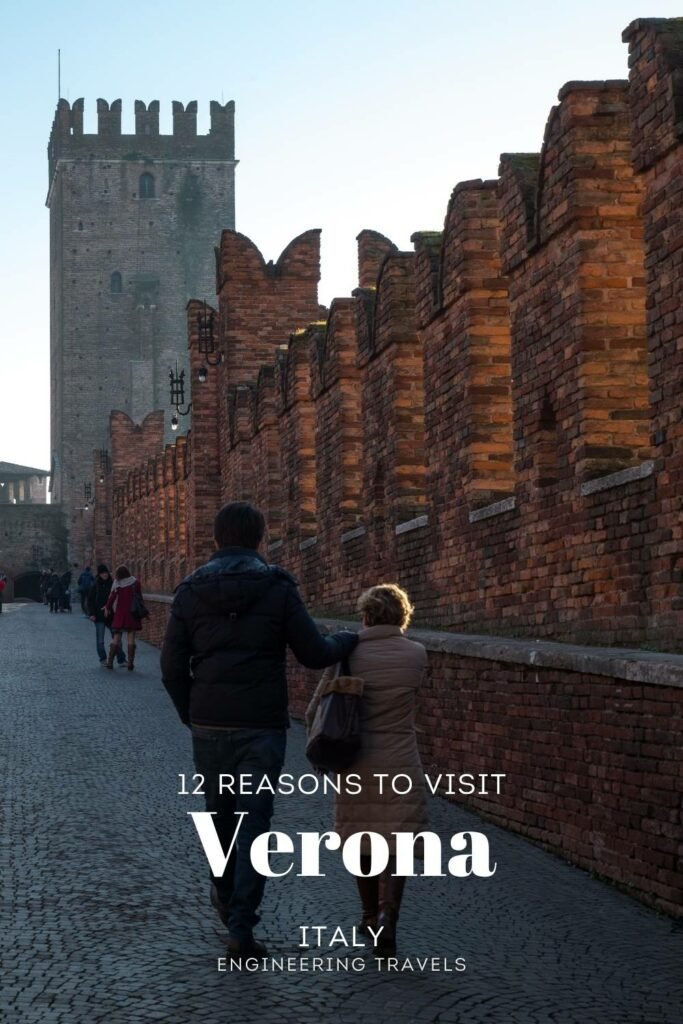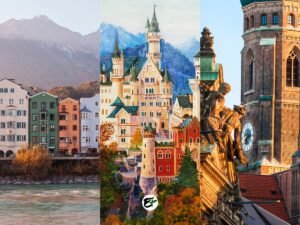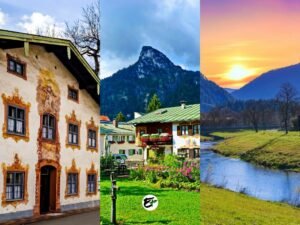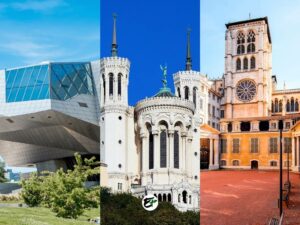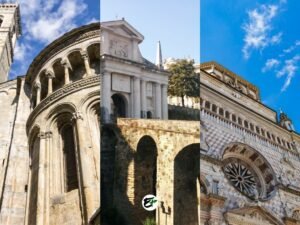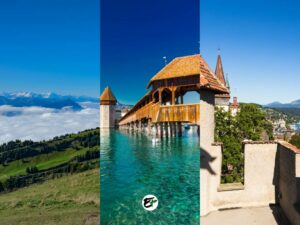Verona In-Depth Guide: 12 Reasons Why It is Worth Visiting
As I was meticulously planning the ultimate trip through Northern Italy, I stumbled upon a gem of a city that surprisingly doesn’t often make it to the “top 10 places to visit in Italy” lists. The name of this overlooked beauty? Verona.
Just like Rome, Verona boasts its own colosseum, or arena. Similar to Venice, Verona is home to romantic bridges. And akin to Florence, Verona is a treasure trove of beautiful architecture and art. Despite these similarities, I’ve often wondered why Verona isn’t as renowned as these cities in the realm of tourism. So, I decided to explore the city myself to find an answer.
Having delved into the tourist attractions and hidden gems of Verona, I can confidently say Verona is the most underrated among the Northern Italian cities I’ve explored. Verona exudes a romantic charm similar to Venice, yet offers a more intimate experience, perhaps due to its association with the timeless tale of Romeo and Juliet.
As you wander through the streets of Verona, it’s easy to envision the star-crossed lovers in the very locations immortalized by Shakespeare. While this distinct character of Verona might be what draws most visitors, I’ve found that there’s so much more to this city that makes it worth exploring.
In this post, I’ll reveal all the fascinating things I uncovered in Verona. Should you decide to Visit Verona, this article can already serve as a guide to help you make the most of your time in Verona.
This post contains affiliate links. I may receive a tiny commission at no additional cost to you.
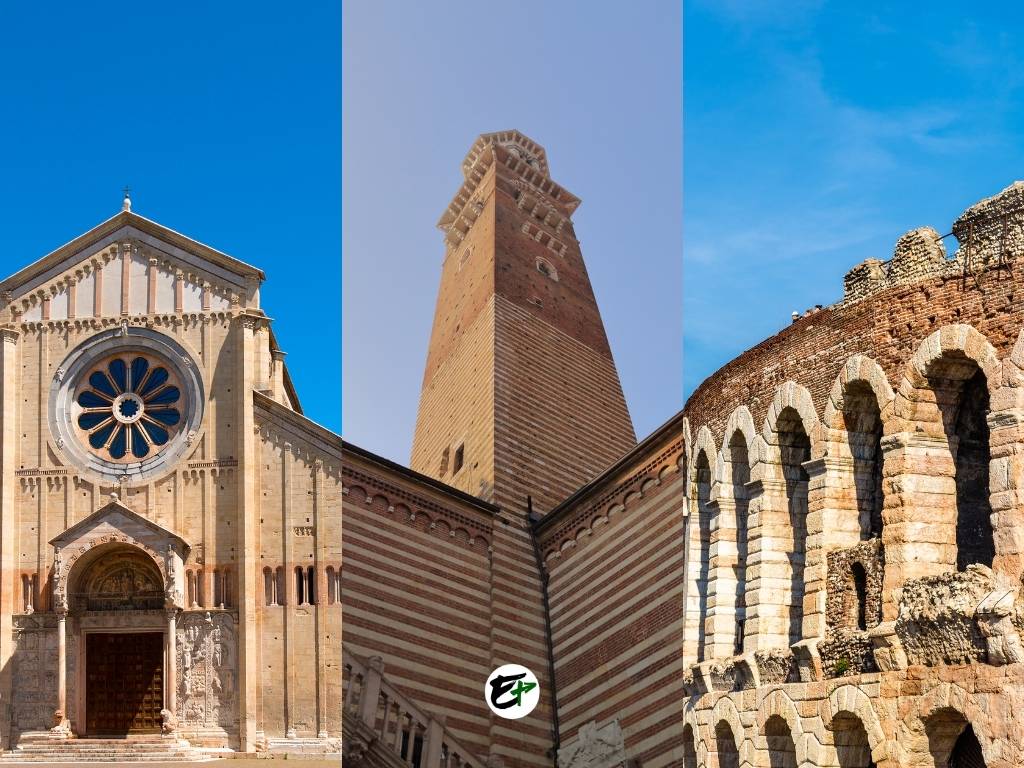
Use the table of contents to skip to topics.
Nestled in the Venetia region of Northern Italy, Verona is a “not-so-hidden” gem waiting to be discovered by the throngs of travelers visiting Italy. Its strategic location between the vibrant cities of Venice and Milan makes it an easily accessible retreat for those in search of a mix of history and romance. Just hop on a train, and within 1.5 hours from either city, you’ll find yourself in the heart of Verona.
The thing is, Verona is a city that wears its history with pride. Its Roman amphitheater, the Verona Arena, stands as a testament to its rich past. This, coupled with an array of ancient and religious structures scattered throughout the city, has earned Verona its endearing nickname – “Little Rome.”
The city’s historic and romantic allure is palpable in its cobblestone streets, charming piazzas, and beautiful landmarks. Literature enthusiasts will definitely find it easy to recognize Verona as the backdrop to one of Shakespeare’s most famous plays — “Romeo and Juliet.”
If you’re planning a trip to Verona, I’ve put together a sample 3-day Verona itinerary that you can easily adapt for a 1 to 2-day stay in the city.
Check out these links to find the best hotel deals in Verona and for a list of the best things to do in the city, including tours and special experiences.
It’s worth noting that Lake Garda, the largest lake in Italy, is merely minutes away from Verona by train or car. Therefore, if Verona is on your itinerary, it’s highly recommended to also pay a visit to the breathtaking Lake Garda.
1. Verona, a City of Love and Romance
What makes Verona a city to love is simple: it is a city of love.
Verona, the backdrop for Shakespeare’s moving love story, ‘Romeo and Juliet’, is a city where couples can discover new depths of connection and inspiration.
Intriguingly, while Shakespeare’s ‘Romeo and Juliet’ is a work of fiction, it was inspired by a real-life couple from Verona who lived between the late 13th and early 14th centuries. Shakespeare is believed to have discovered this tragic love story through Arthur Brooke’s 16th-century poem, ‘The Tragical History of Romeo and Juliet.’
As Verona embraces this cultural heritage, every part of the city has something romantic to offer.
Landmarks like Juliet’s balcony at Casa di Giulietta (Juliet’s House) in Cappello Street (house number 23) help bring the bittersweet love story of Romeo and Juliet to life. It is said that this 13th-century edifice is where Romeo first courted Juliet. A bronze statue of Juliet graces the courtyard of Casa di Giulietta, and many believe that touching her right breast will bestow good luck in matters of the heart.
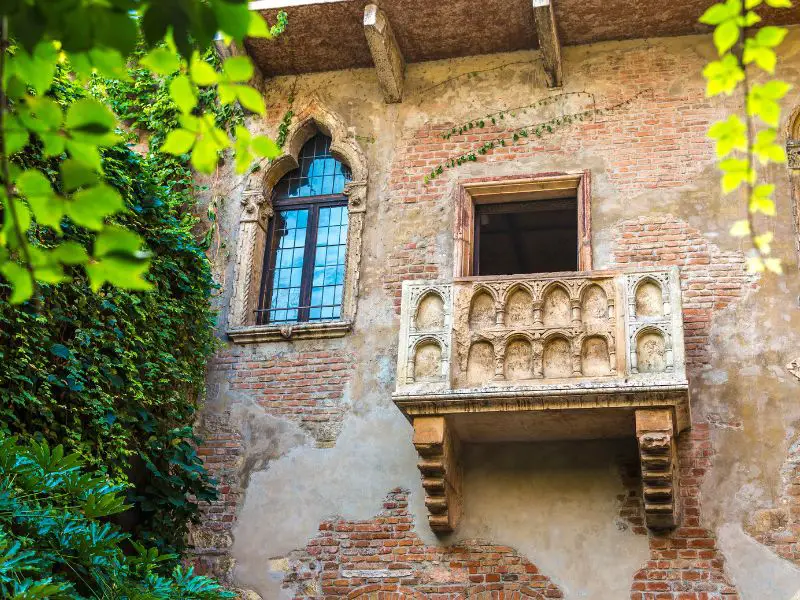
The house and courtyard, which showcase the iconic balcony, are accessible for free (museum and balcony access not included), drawing in many curious visitors. So, if you are going to Verona to see visit this be prepared – Juliet’s House can attract a large number of tourists, especially during high season.
Don’t let the crowd spoil your moment when you see the balcony in Verona. Arrive early in the morning to fully immerse yourself in the scene where Romeo wooed Juliet. Juliet’s House is open from Tuesday to Sunday, 9 am to 7 pm (last entry at 6:30 pm). For more information, please check the official website of Verona.
The story of Romeo and Juliet has made Juliet’s Balcony a popular attraction in Verona, but it is not the only place where you can experience the city’s romantic atmosphere.
The city is full of beautiful structures that surrounds its visitors with romantic flair. You can also admire the historic arches, towers, and bridges that dot the city, such as the Ponte di Pietra Bridge, Piazza delle Erbe, Piazza dei Signori, Arco dei Gavi, and Colle San Pietro.
You may come across a well that looks like it belongs to the Middle Ages. That is the Well of Love, and it has a tale of its own.
Its tale? It is the legend of the Well of Love, where a young soldier named Corrado and a beautiful girl named Isabella met their fate.
Corrado loved Isabella, but she seemed to reject him. One day, he accused her of being cold as the water in the well. She challenged him to jump into the well to prove his love. He did, and she realized that she loved him too. She followed him into the well, and they died together.
The well is in a courtyard near the Church of San Marco, in a small street called Vicolo San Marco in Foro. You can see a plaque above the well that says you can make a wish for your love by throwing a coin.
2. Verona Arena & Operas
Verona is not just a destination for couples, but for anyone who loves history, architecture, and art. You can visit Verona with your friends, family, or even by yourself and have a wonderful time.
The city has many attractions that will amaze you, such as the Verona Arena. This ancient landmark is the main attraction of Verona and it will take you back to the time of gladiator fights, just like the Roman Colosseum in Rome.
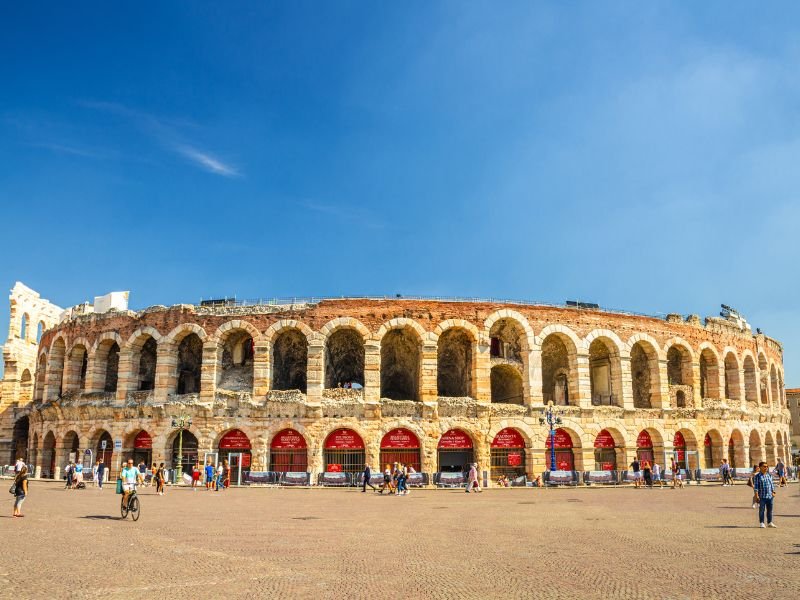
The arena is over 2000 years old and has survived natural disasters such as the earthquake of 1117. It has been restored several times, but it still preserves its original shape and structure. The arena’s architectural style is still Roman, but with some changes and additions.
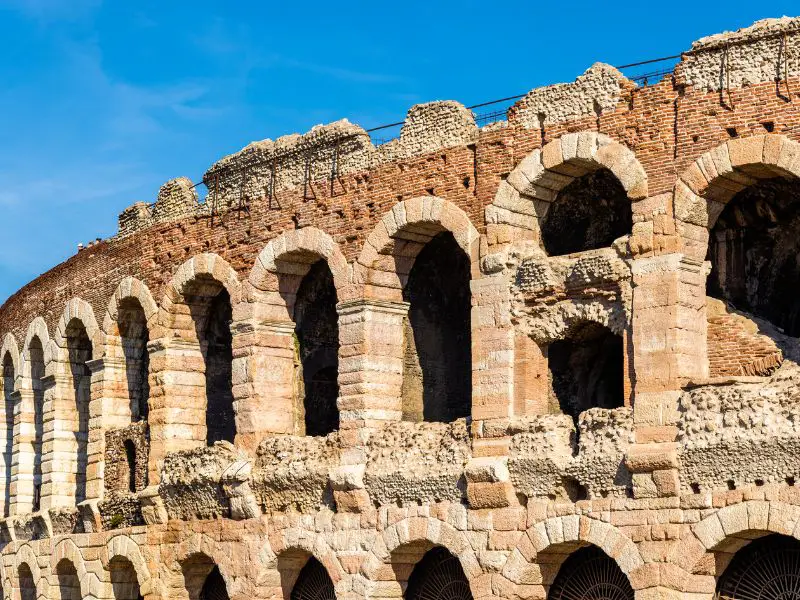
The only part of the outer ring that remains is the wing, which reminds us of how the arena looked like in the past. 152 meters long and 123 meters wide, Verona Arena is one of the biggest Roman amphitheatres in the world.
You know what’s amazing about the arena’s architecture? It’s huge and it makes the sounds inside the arena great. It has such good acoustics that you can hear everything clearly without too much amplification.
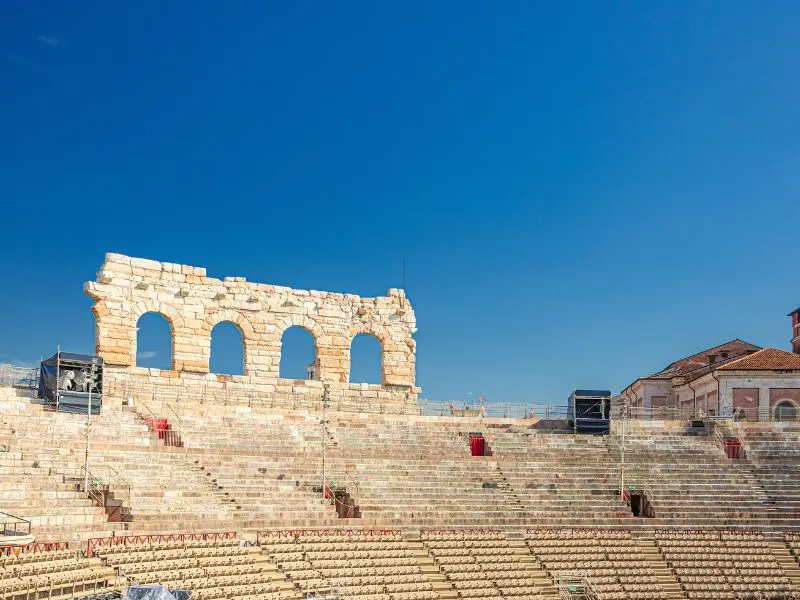
Want to try its acoustics? Watch Verona Arena’s opera under the stars, where you can enjoy some of the most famous operas in the world, like Aida, Carmen, Turandot, or Tosca.
Aside from the acoustics, the opera is a unique experience because you can feel the history, culture, and emotion of the arena. You can see a live performance that connects you with thousands of years of human history and artistic expression. And at the end of the show, you can join the tradition of waving a white handkerchief to show your appreciation. It’s awesome!
If you’re attending the night opera show and you want to be more comfortable at the arena, you can rent some cushions there, but you don’t need them if you have seats with chairs. You can also get some blankets there or bring your own if you get cold at night.
Bringing food inside the Verona Arena isn’t allowed. You can buy some snacks and drinks at the arena or outside before or after the show.
By the way, you can also check out the arena during the day, if you want. You can book a guided tour or get an audio guide. Tickets are available online or at the box office.
On regular days, there’s no special pass for the arena, but you can get a ticket that lets you see other things in Verona too. For example, you can get a Verona Card that gives you access to more than 20 museums, monuments, churches, and public transport in Verona for 24 or 48 hours. Or you can get a Verona Opera Pass that gives you access to three opera shows at the arena for a cheaper price.
You know what’s the best time to see the arena and watch an opera?
It’s during the summer season when they have the opera festival, the Arena di Verona Opera Festival. It’s one of the best opera festivals in the world, and they have all kinds of operas, concerts, ballets, and special events that you don’t want to miss if you’re in Verona in summer.
You can check out their website to learn more. But, just a heads up, summer is also the most crowded and pricey time to visit, so you should get your tickets and hotel booked early and be ready for lots of people and lines.
3. Beautiful Architecture in Verona
Verona is a city that has a story to tell which you can discover not only through the operas from its arena.
This story — it that spans over two millennia, from the ancient Romans to the modern Italians. A story that is written in stone, brick, and marble. A story that is recognized by UNESCO as a world heritage site. Verona is a city that showcases the best of art and architecture from different eras.
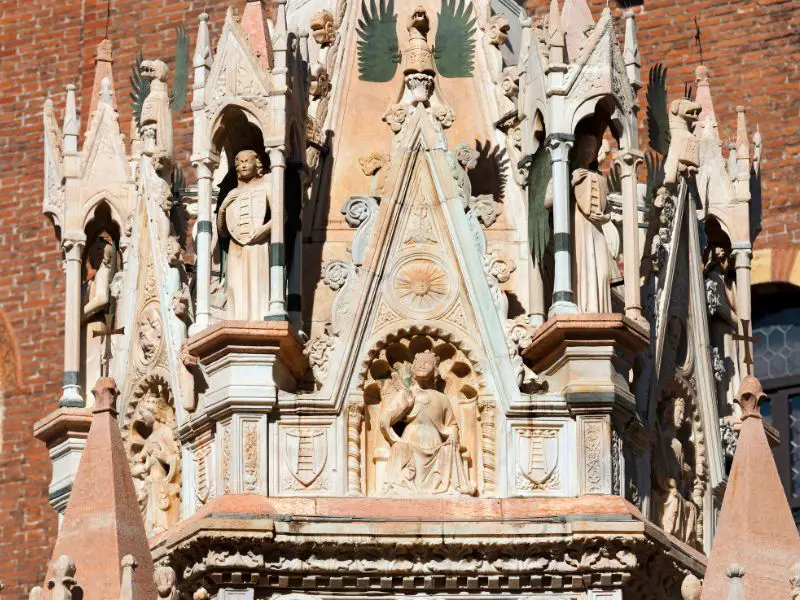
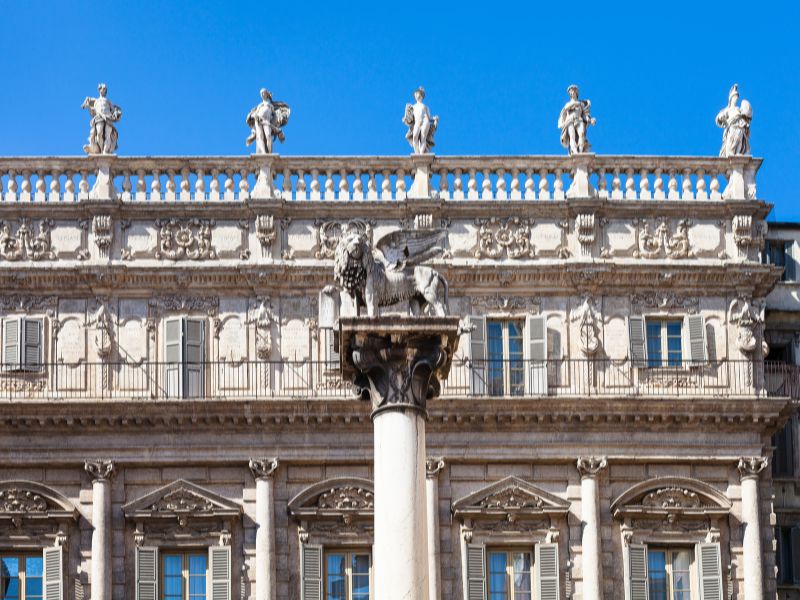
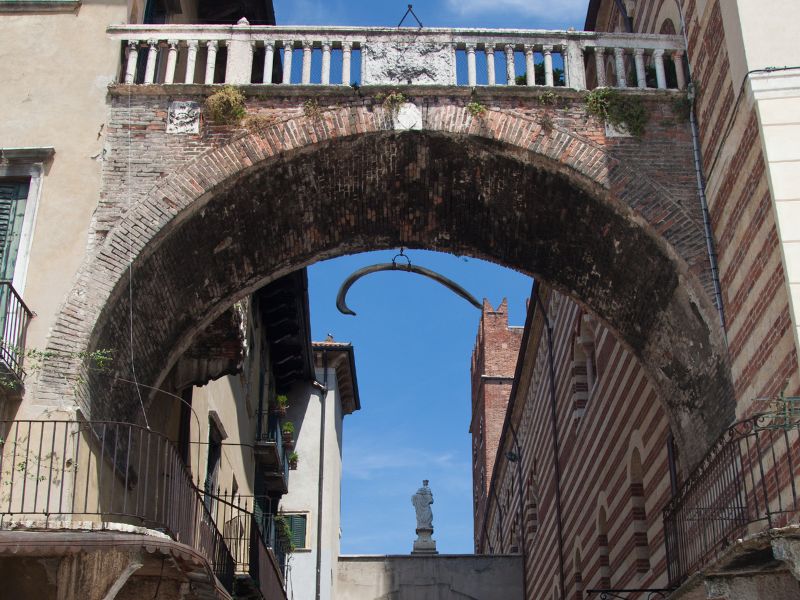


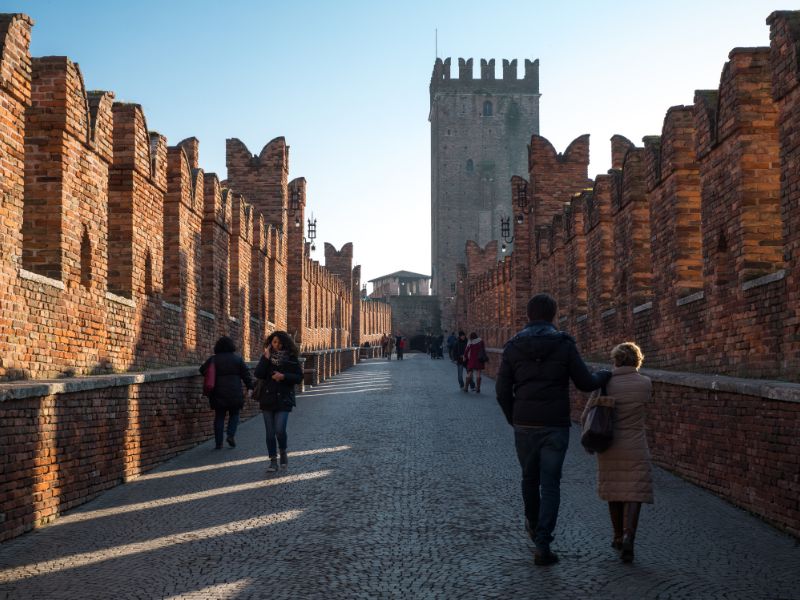
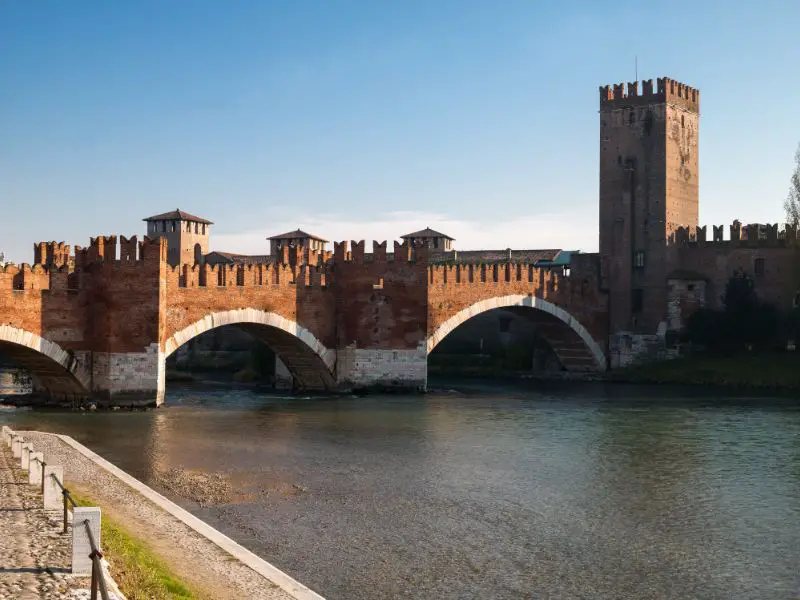
Where to begin? After Verona Arena, the best you can go to the Castelvecchio which is a testament to the power and influence of the Scaliger dynasty.
This imposing structure, built entirely of red bricks, stands as one of the finest examples of Gothic architecture. Its stark and robust design is a stark contrast to the ornate and decorative style typically associated with this period.
Sant’Anastasia is another must-see. It’s a church that is as much a part of Verona’s history as it is its skyline. The interior is a symphony of art and light, creating an atmosphere that is both heavenly and inviting for a prayer.
Just a short walk away is the Duomo Di Verona, a magnificent cathedral dedicated to the Blessed Virgin Mary. The cathedral’s Romanesque style exterior gives way to a stunning interior, where tall red Verona marble pilasters support Gothic arcades.
After exploring these architectural wonders, it’s time for a leisurely stroll through the Giardino Giusti. Created in the late 1400s, this garden is considered one of the most beautiful Renaissance gardens in Europe. The terraced layout offers breathtaking views of the city.
Crossing the Adige River, we come upon the Ponte Pietra, Verona’s oldest bridge. This Roman arch bridge, completed in 100 BC, has stood the test of time and remains an iconic part of Verona’s cityscape.
Last, I’ll mention (but there’s more) is Castel San Pietro, perched high on San Pietro hill. Built by Giangaleazzo Visconti in 1398, this castle offers panoramic views of Verona.
If you love castles, you’ll be amazed by these two gems in Germany. They are Neuschwanstein Castle and Lichtenstein Castle, and they look like they came straight from a fairy tale. Check them out!
4. Medieval Pilgrimage Churches
Verona’s spiritual character has been at the heart of the city since medieval times.
For centuries, Verona has been known as the “little Jerusalem,” attracting countless pilgrims to its churches. Legend has it that the city was founded by Shem, the son of Noah, and was originally named “Minor Jerusalem.”
It served as a helpful alternative for European pilgrims who couldn’t make the journey to the Holy Land. To this day, Verona is a famous pilgrimage site that preserves its unique character from centuries past.
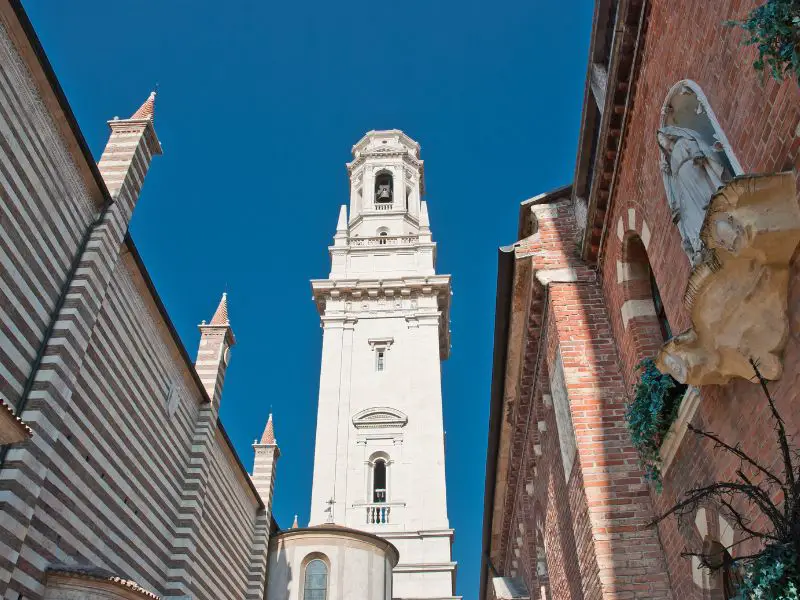
The churches that medieval pilgrims have visited in the past still exist today. And they offer a compelling reason to visit Verona for their historical, artistic, and religious significance.
To get the most out of your visit, consider the checking foundation created by the diocese of Verona, Verona Minor Hierusalem. This foundation offers routes you can follow, and they have volunteers to guide you in discovering each pilgrimage site in the city.
Their itineraries include Rebirth From Water, Rebirth From Earth, and Rebirth From Heaven.
The itinerary, Rebirth From Water, includes six churches on the left of the Adige River. These churches are the church of San Giovanni in Valle, Santi Siro and Libera, Santo Stefano, San Giorgio in Braida, San Pietro Martire, and Santa Maria in Organo.
This route, a circular path stretching approximately 3.5 kilometers, is your path to tranquil discovery, symbolically starting in Ponte Pietra across the River Adige. As you pursue the path of Rebirth From Water, you’ll be treated to breathtaking views of the city from two panoramic terraces – Castel San Pietro and San Zeno in Monte.
From this vantage point, you can admire the Roman Theatre from above and stumble upon water fountains that whisper tales of the ancient and echo stories of the new.
Rebirth From Earth itinerary also includes six churches, San Zeno in Oratorio, San Lorenzo, Sante Teuteria and Tosca, Sant’Eufemia, San Giovanni in Foro, and San Benedetto al Monte.
The route follows the old Via Postumia, the road that runs in the heart of Verona. It has wealth of monuments — from the remnants of Roman civilization to the awe-inspiring Scaligeri Castle, and the grand palaces lining Corso Cavour. Along the way, you’ll also encounter sacella, small sacred spaces used for worship, and crypts hidden beneath the city’s surface.
By the end of this path, you should have gained new insights into the history of Verona.
Last but not least is the itinerary, Rebirth From Heaven.
It includes the churches in the multicultural district in Verona of Veronetta: Santa Toscana, Santa Maria del Paradiso, San Tommaso, San Paolo, and SS. Nazaro and Celso. This journey is a harmonious blend of history, traditions, music, and art — an experience that metaphorically represents the human journey from earthly existence to celestial transcendence.
You can begin your exploration of these historic churches at the Verona Minor Hierusalem foundation’s headquarters, nestled within the Church of San Pietro Martire. The information point is open for visitors from Thursday to Sunday, between 10 am and 5:30 pm. For more details about the foundation, you can visit their contact page.
5. Veronese Renaissance Art
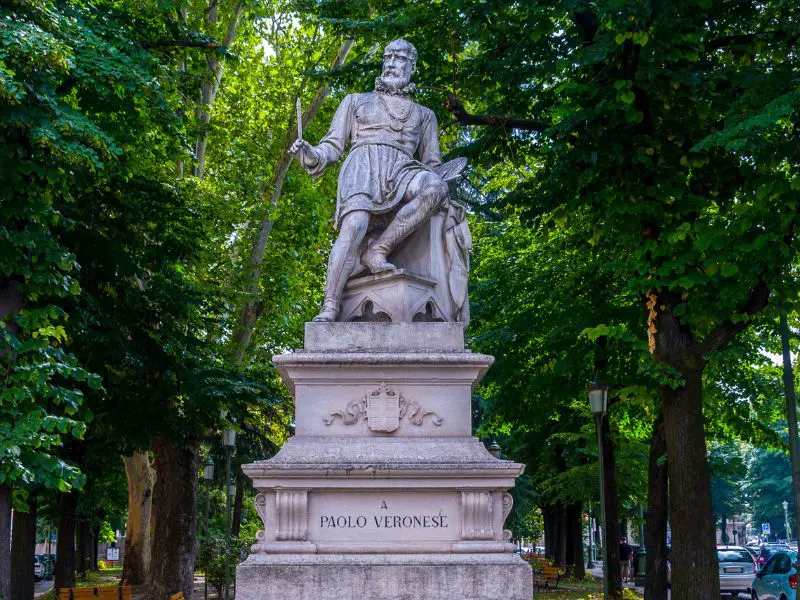
Art is an integral part of Verona’s rich heritage; another thing to love about Verona.
From the sacred walls of churches to the historic castles and lively city squares, artistic expressions are woven into the city’s fabric. But did you know that Verona takes pride in its very own artist? That’s Paolo Veronese.
Paolo Veronese, born as Paolo Caliari, was a distinguished painter from the Italian Renaissance, renowned for his grand history paintings that depict religious and mythological themes. Born in Verona in 1528, he’s often referred to by the name of his birth city.
Veronese’s artistry is admired for its clear storytelling through intricate and thoughtful compositions that are vibrant and full of painterly effects. He was a master of color and, after an early period with Mannerism, he developed a naturalist style of painting, influenced by Titian.
His works are known for their elaborate narrative cycles, executed in a dramatic and colorful style, complete with majestic architectural settings and glittering pageantry. He is particularly famous for his large paintings of biblical feasts, filled with figures, painted for the refectories of monasteries in Venice and Verona.
In Verona, you can admire his masterpieces in the churches that are part of the “Rebirth from Heaven” itinerary created by the Diocese of Verona which we discussed previously.
Three artworks by Paolo Veronese have etched themselves into my memory.
The first one that stands out is his depiction of ‘Saint George’s Martyrdom,’ housed in the Church of San Giorgio. This painting offers a unique narrative, focusing on the martyrdom of Saint George, a theme less frequently portrayed compared to the famed legend of Saint George slaying the dragon. Created in 1566, this oil-on-canvas masterpiece was born during a pivotal phase in Veronese’s life.
It was a time when he returned to his hometown, Verona, to marry Elena, the daughter of his esteemed mentor, Antonio Badile.
When you make your way to Castelvecchio, be sure to seek out Veronese’s ‘Deposition of Christ.’ This oil-on-canvas masterpiece, dating back to 1548-1549, is a testament to Veronese’s signature style. It poignantly captures the moment when Christ is being lowered from the cross after his crucifixion.
Another must-see artwork at Castelvecchio is ‘Pala Bevilacqua Lazise.’ This gem from 1548 was commissioned by the Bevilacqua-Lazise family for their funerary chapel in San Fermo Maggiore church in Verona.
The painting depicts a tranquil scene of the Virgin Mary and baby Jesus, surrounded by saints and angels. Its harmonious composition, elegant figures, and intricate details reflect Veronese’s naturalist style, bearing traces of Titian’s influence.
6. The Picture-Perfect Basilica di San Zeno
What makes Verona more interesting is a landmark where art, spirituality, scenic beauty, and romantic heritage come together in a breathtaking blend. This place is none other than the Basilica di San Zero.
While it isn’t the most beautiful church in Italy, it is still a sight you’ll undoubtedly won’t regret seeing.
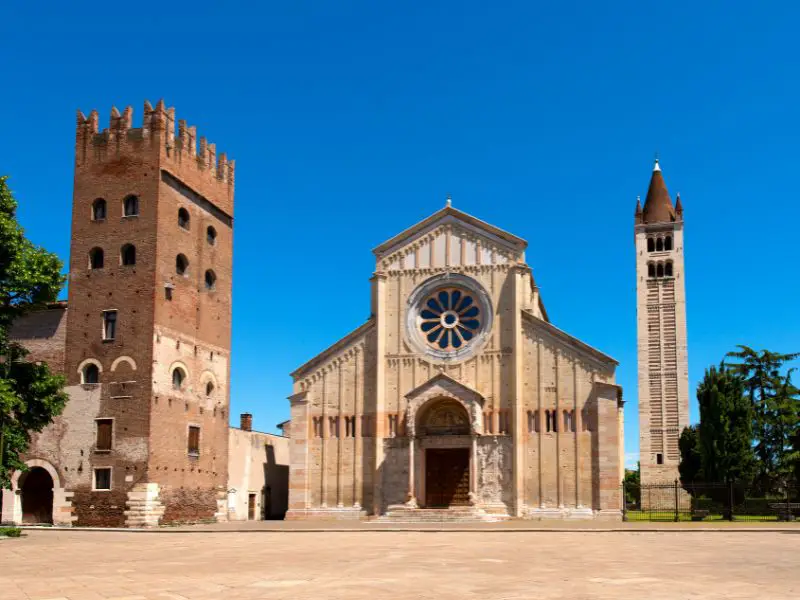
The Basilica of San Zeno, with its construction spanning four centuries from 967 to 1398 AD, is one of Verona’s most iconic landmarks.
Its fame is partly due to Shakespeare’s Romeo and Juliet, as it was within the crypt of this very basilica that the star-crossed lovers were wed in the tale. However, even without this literary connection, the basilica would undoubtedly be one of Verona’s premier attractions.
With its stunning interiors, remarkable artworks, and unique architectural design, the Basilica of San Zeno is undeniably a sight to behold.

A visit to the Basilica of San Zeno transports you to the heart of the Middle Ages. The church’s murals and bas-relief sculptures serve as silent storytellers, recounting life from centuries ago. Artworks depicting saints, biblical narratives, and mythical creatures embellish the basilica’s portals, balconies, and walls.
Be sure to take in the stunning altarpiece, the beautifully detailed bronze door, and the crypt that holds the relics of San Zeno.

The altarpiece of the San Zeno Basilica is a stunning example of Byzantine iconography, intricately crafted with remarkable detail. This beautiful triptych, a masterpiece by the Italian Renaissance painter Andrea Mantegna, took three years to complete, from 1457 to 1460. The artwork depicts the Madonna and baby Jesus enthroned, surrounded by various biblical events.
A unique feature of the basilica you must also lay your eyes upon is the bronze door. This door, with its medieval charm and 48 square panels – some of which date back to the 11th century – is one of Italy’s unique treasures. Notably, some of these panels were created by the Saxon masters from Hildesheim in Germany.

Don’t miss out on exploring the crypt when you visit the Basilica of San Zeno.
But if you’re looking for that picture-perfect moment for your Instagram feed, make sure to visit the cloister. With its arcades and columns, red bricks, and lush greenery, it’s a photographer’s dream. The vibrant colors are simply irresistible to capture.
And if you’re lucky enough to visit on a sunny day, the intense light dramatically transforms the scene, creating a stunning contrast.
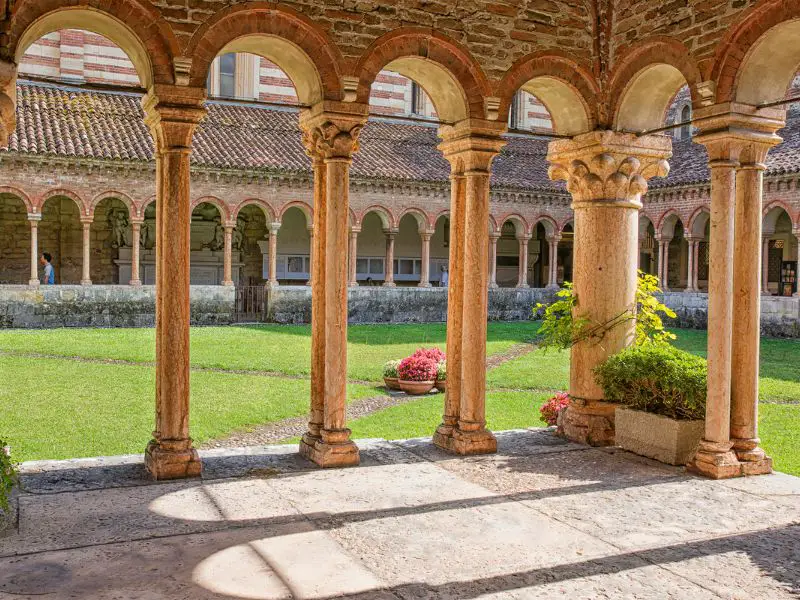
With all these treasures waiting to be discovered in the Basilica of San Zeno, it’s no hard to understand why this church is considered a top reason to visit Verona!
7. The City Walls of Verona
Wandering through Verona, much like Rome, you’ll be amazed by the ancient landmarks that have withstood more than 2000 years. It’s quite a contrast to our modern buildings that, despite all our technological advancements, only last a few decades.

Another sight you’ll appreciate in Verona is its city walls and gates, some of which remain intact today. They may not look spectacular, but they provide a window into life in northern Italy during ancient times.
Did you know that some sections of these walls were built in the 1st century BC? That’s over two millennia ago! Again, seeing them still standing is truly remarkable.
As the city grew, new walls were constructed, remnants of which can still be found in Verona today. The city walls of Verona can be found in various parts of the city, but the most significant sections are undoubtedly the Porta Borsari and the Porta dei Leoni. Situated on the east and west sides of the old town, or Citta Antica, these gates hold a wealth of history.
Porta Borsari, in particular, served as the main gateway to the ancient city of Verona in the first century.
While some visitors might dismiss it as just an old crumbling wall, it’s actually a remarkable piece of history that deserves a closer look: An inscription from the reign of Emperor Gallienus reveals another reconstruction in 265 AD.
Originally known as Porta Iovia due to its proximity to a small temple dedicated to Jupiter lustralis, it was later referred to as Porta di San Zeno in the Middle Ages. The current name, Porta Borsari, is derived from the term ‘bursarii’, referring to the guard soldiers who were paid the ‘dazio’.
In contrast to the well-preserved Porta Borsari, only a fragment of Porta dei Leoni, located on Verona’s other side, survives today. Nonetheless, it offers an intriguing visit. Next to it lie the underground remnants of ancient Roman baths. These ruins are intriguingly nestled in the heart of the street, allowing passersby a sneak peek into history.
Should you feel hungry, numerous cozy cafes surround the site for a relaxing respite post-exploration. Additionally, a range of dining options can be found in the vicinity of Porta Borsari.
Do you want to see towns and villages with intact medieval walls? Discover Aigues-Mortes, Rothenburg-ob-der-Tauber, and Lucerne.
8. Panoramic City Views of Verona
It’s undeniable: a city without a scenic viewpoint lacks a certain romantic charm, don’t you think?
We all crave that perfect sunset spot to end our day on a romantic note. In Verona, you’ll find numerous viewpoints that offer truly stunning golden hour vistas of the city skyline. Among the viewpoints in Verona, Torre Dei Lamberti, also one of the landmarks that shape the city skyline of Verona, is the most famous.
Torre Dei Lamberti
The Torre dei Lamberti, standing tall at 84 meters, is a testament to the legacy of the influential Lamberti family who began its construction in the 11th century. The tower has witnessed several historical events, with its two bells – the Marangona and the Rengo – signaling fires, work times, and calling the population to arms.
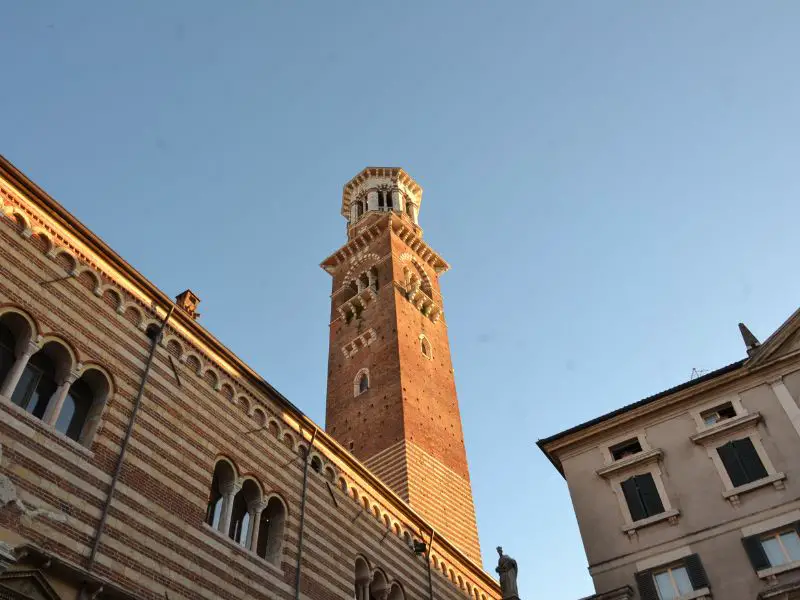
Today, the tower serves as a popular tourist attraction by day and transforms into an enchanting rooftop terrace for exclusive events by night. You can choose to climb its 368 steps or take a transparent elevator to reach its panoramic terraces.
From the heights of Torre dei Lamberti, you’ll be treated to more than just a bird’s eye view of Verona’s rooftops, church spires, and city towers. On a clear day, your gaze can wander beyond the Adige River, all the way to the snow-capped peaks of the Alps.
Here’s the official website of Torre dei Lamberti for more information.
Ponte Pietra
The Ponte Pietra, or Pons Marmoreus, is a Roman arch bridge that has stood over the Adige River in Verona since 100 BC. Built by the Romans to provide access to their theatre, it’s seen its fair share of history.
The bridge has been destroyed and rebuilt several times, most notably in 1945 during World War II, only to be lovingly restored in 1959.
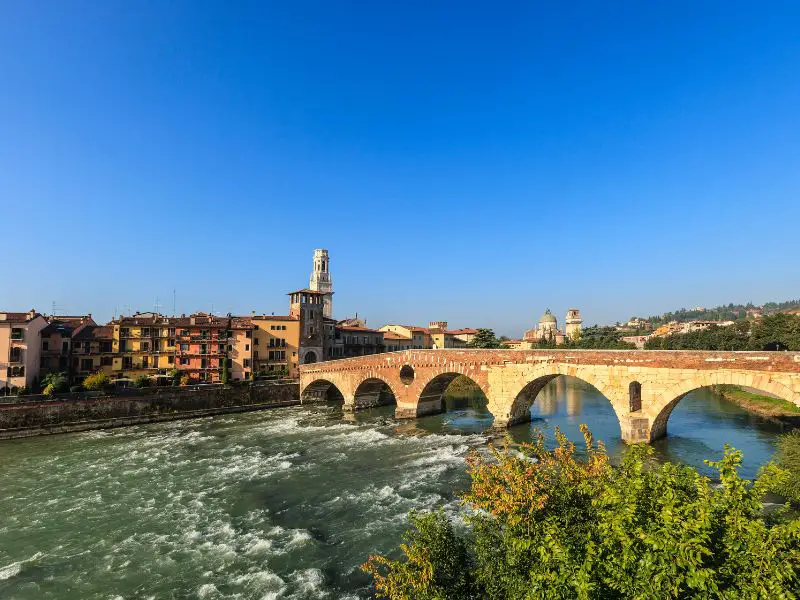
Walking across the bridge, it’s hard not to think that despite the trials of time, the Ponte Pietra retains its original Roman architectural style. Its Roman arches and smooth stone surface are a testament to the engineering prowess of the Romans. The two central brick arches, remnants from the Middle Ages, add a touch of historical charm.
Today, the Ponte Pietra is more than just a bridge; it’s a window into Verona’s past and a popular tourist attraction.
As you walk across, you’ll be treated to stunning views of the Adige River and the cityscape beyond. It’s an experience that’s available to everyone, anytime.
In my opinion, the most breathtaking view of Ponte Pietra can be found at Rigastre Redentore, just across Piazza del Foro. From this spot, you’ll see the bridge set against the picturesque backdrop of Verona’s hilly side. The welcoming tower that greets those crossing Ponte Pietra, connected to the bridge itself, is a sight to behold.
Santuario della Nostra Signora di Lourdes
As you stand on Ponte Pietra and gaze northward, your eyes will be drawn to the San Leonardo hill, crowned by a striking white edifice. This is the Santuario della Nostra Signora di Lourdes, another gem in Verona’s scenic landscape.
This spot is yet another picturesque locale in Verona, offering additional sweeping vistas for your viewing pleasure.

The Santuario della Nostra Signora di Lourdes has a rich history that dates back to 1908. Despite being destroyed during World War II, the sanctuary was lovingly rebuilt on a hill overlooking Verona, transforming an old Austrian fortress into a beacon of hope.
Today, the sanctuary serves as a place of pilgrimage. Its tranquil setting offers a peaceful retreat from the hustle and bustle of city life. When you arrive and looked around, you’ll notice that the sanctuary’s architecture is a blend of modern and eclectic styles, with its circular shape being one of its most distinctive features.
Come inside, you’ll find a treasure trove of art, including fifteen bas-reliefs depicting the Mysteries of the Holy Rosary.
However, it’s the panoramic view from the sanctuary that will make your visit unforgettable. The Santuario Della Nostra Signora di Lourdes boasts a spacious, sun-drenched balcony, framed by picturesque trees that stand like columns around the church.
As you approach the concrete guardrail at the edge of the area, prepare to be stunned by the sweeping vistas of north-central Italy’s vast plains, the entire city of Verona, and the winding Adige River.
Want to visit? You can find this sanctuary at Colli Street in Verona. It’s just a short 20-minute walk from Ponte Pietra or a quick bus ride from Borgo Trento if you’re coming from the train station. The sanctuary welcomes visitors every day from 7:30 am to 12:00 pm and again from 3:00 pm to 7:00 pm.
For more details about tickets or special passes, it’s best to check their official website or give them a call.
Castel San Pietro
Even without a car or the desire for a long walk, you can still capture a stunning view of Verona from a single location.
Your destination? Castel San Pietro. Conveniently located just a 5-minute stroll from Ponte Pietra, it’s the perfect spot for panoramic city views.
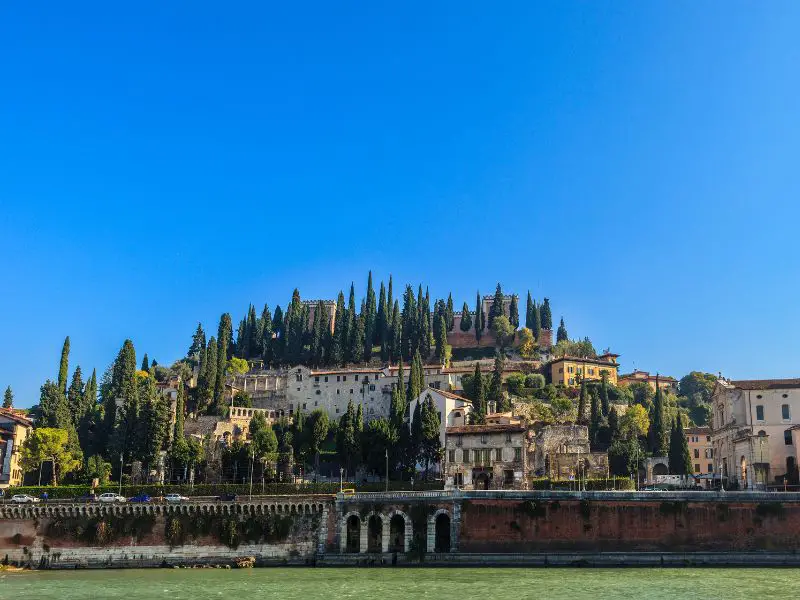
Castel San Pietro has a rich history that dates back to 890 when Berengarius built a castrum.
Over the centuries, it underwent significant changes. In 1393, Gian Galeazzo Visconti commissioned a complete reconstruction. Unfortunately, the castle was largely destroyed by the French in 1801, and later the Austrians completed the demolition. Between 1852 and 1858, they built fortified military barracks on the grounds.
While the castle itself is not open to the public due to its deteriorated condition, you can still enjoy a visit. A footpath and stairs starting from Ponte Pietra leads you up to the castle.
The real treat is the terrace before the castle which offers an invaluable panoramic view over Verona and the archaeological area of the Teatro Romano.
The view from Castel San Pietro is truly breathtaking, much like the one from Santuario Della Nostra Signora di Lourdes. However, from here, you’ll get a closer look at the Citta Antica of Verona and the River Adige.
Keep in mind that it might be a bit more crowded here than at Santuario Della Nostra Signora di Lourdes, as it’s a bit more accessible.
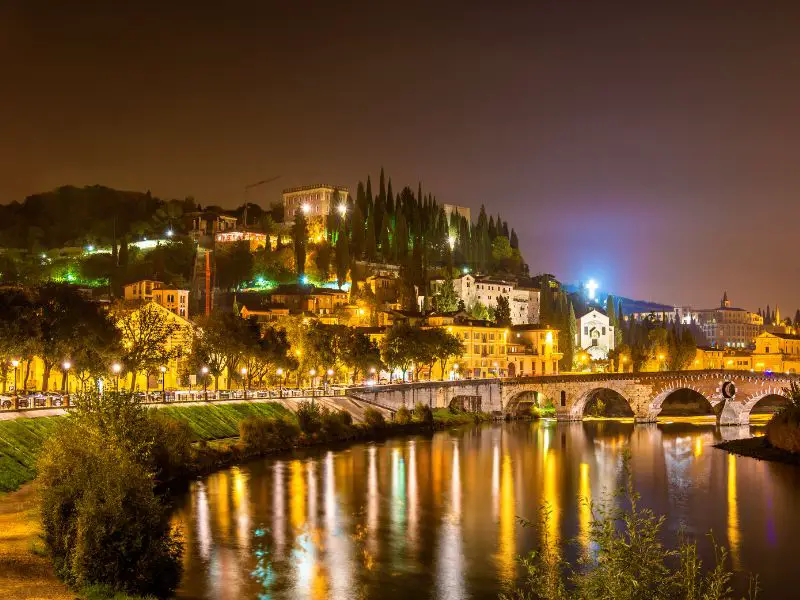
Not a fan of stair climbing? Don’t worry, there’s a funicular to Castel San Pietro conveniently located behind the Chiesa di Santo Stefano. This ride to the top is not only a knee-saver but also a unique experience. Check out the funicular’s operating hours and other details here.
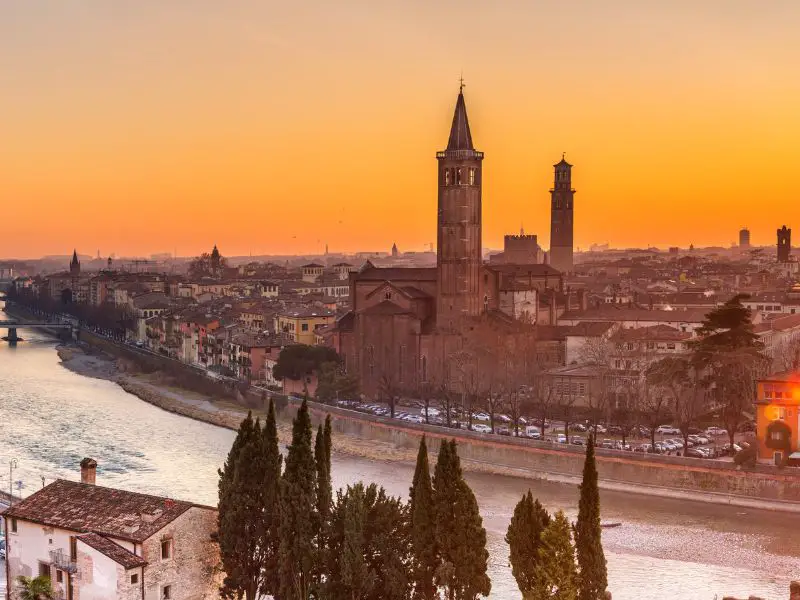
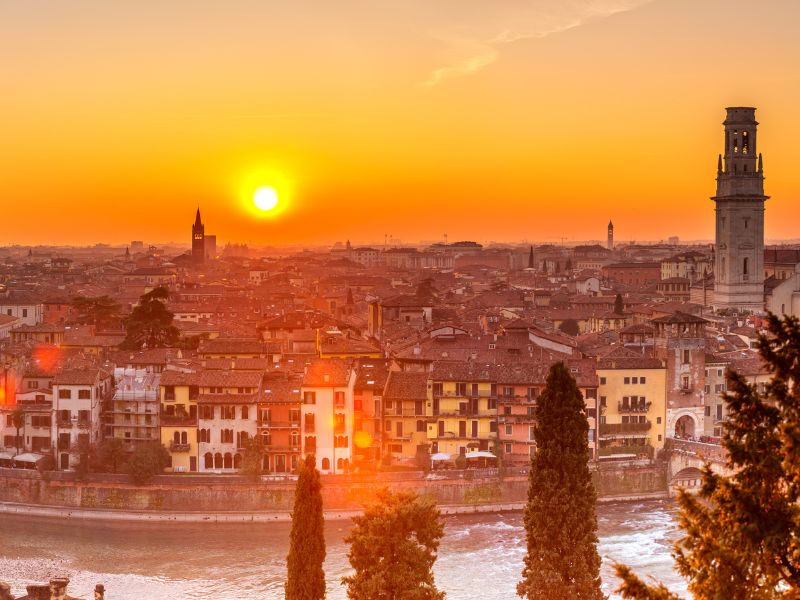
Are you like me? I love cities with panoramic views like Verona. Seeing such scenery gives me a weird feeling, like I did not miss anything during my visit. Here are other European cities which also have panoramic views: Paris (from Eiffel Tower), Lyon (from La Basilique Notre Dame de Fourvière), Avignon (from Jardin des Doms), Bern (From Rose Garden), Nuremberg (from Imperial Castle), and Stuttgart (Stuttgart TV Tower).
9. Wines of Verona
Imagine strolling through the medieval streets of Verona, the city of Romeo and Juliet. The architecture, the history, the romance, it’s all there.
But there’s something else that makes Verona truly special — its wines. Verona is capital of Italy’s wine trade. The province of Verona is home to some of the most famous wines in Italy, including Amarone and Recioto from Valpolicella, Bardolino, Recioto from Soave, Custoza, Soave, Lessini Durello and Lugana.
Wine isn’t just a beverage in Verona; it’s a way of life! Just outside the city begins the vineyards of the Valpolicella region.
Once known for producing cheap table wines, today it’s producing some of Italy’s finest red wines. Many winemakers open their doors for tastings and even offer bed and breakfast accommodations. The experience of sipping a light Valpolicella Classico or a potent Amarone while enjoying the hearty cuisine of the Veneto region is something that can make your visit to Verona even more memorable.
There are plenty of rustic osterie and family-run agriturismi where you can enjoy these fine wines. If you’re interested in tasting some of these exquisite wines, there are several places in Verona that offer wine tasting experiences.
Small wineries offer a chance to learn about how the wines are produced and aged directly from the winemaker. You can also check out Degustazione Vini // Wine Tasting Verona and Pagus Wine Tours for a great wine tasting experience.
Here’s where you can find the best wine tours in Verona.
Interested in wines? Compare Verona with other cities in Europe listed below.
- Reims. This city is one of the centers of the UNESCO Champagne region in France, where you can drink freshly made Champagne and discover how they are made.
- Geneva or Montreux. From these cities, you can visit the UNESCO Lavaux vineyard. It has unique wines you can only buy in the area. You’ll also love the view of the French and Swiss Alps from the vineyards.
- Carcassonne. It is one of the most preserved medieval cities in Europe. There are plenty of wine-growing industries around it. And you can have a wine-tasting tour after wandering in its time-transporting streets.
- Wurzburg. It is one of the towns in Franconia (the part of Bavaria in Germany famous for wines). In one of Wurzburg’s tourist attractions lies the largest fresco in the world!
10. Verona’s Vibrant Market Square
For those of us with a passion for exploration, the thrill of encountering lively and vivid European squares is unparalleled. Piazza Delle Erbe in Verona perfectly embodies this experience. It’s a mini destination that makes the journey to Verona all the more worthwhile.

Once the bustling forum during the Roman Empire, Piazza Delle Erbe has transformed into a vibrant marketplace, brimming with life and color. As you stroll through the square, you’ll find yourself surrounded by a rich tapestry of architectural marvels.
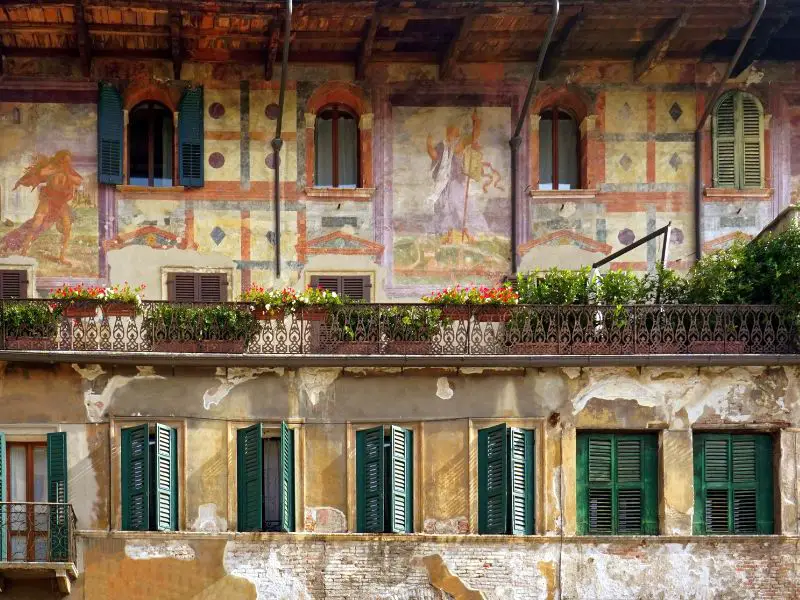
On the northern side, the ancient town hall, the towering Torre dei Lamberti, the Casa dei Giudici, and the frescoed Mazzanti Houses stand as silent witnesses to Verona’s illustrious past.
To the west, the Baroque Palazzo Maffei reaches for the sky, its façade adorned with statues of Greek gods. The buildings around the square are a canvas of façade frescoes, each one a masterpiece in its own right.
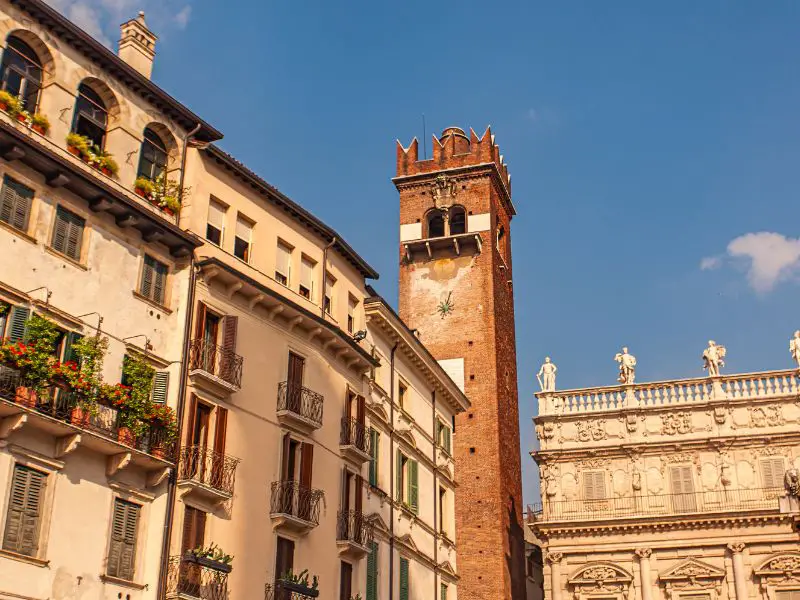
Piazza delle Erbe is not just about history and architecture. It’s also a paradise for food lovers and shoppers. The daily market is a feast for the senses, offering everything from fresh fruits and vegetables to souvenirs and local products.
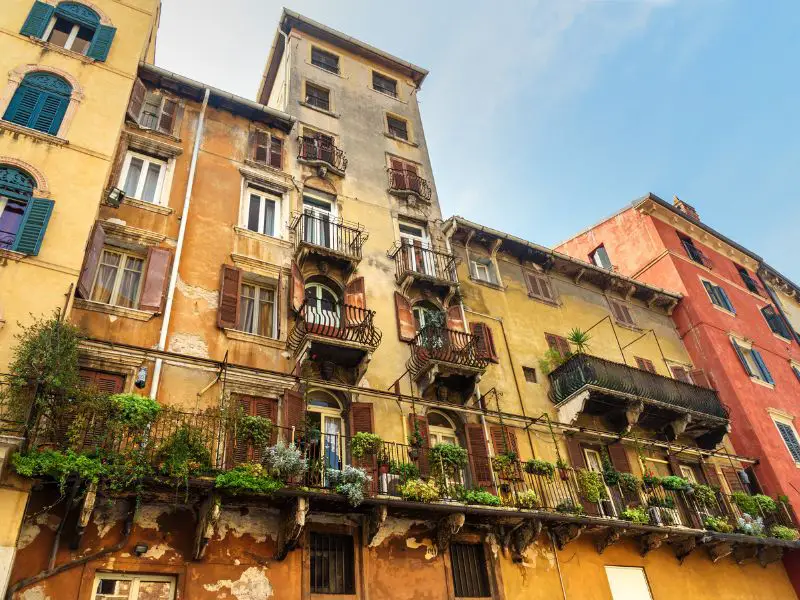
After a day of exploration and shopping, you can unwind at one of the many nearby restaurants. Whether it’s Hi Poke’s Hawaiian bowls or Berbere Verona’s artisanal pizzas, there’s something to satiate every palate.
11. Verona is a Picturesque City
Whether you’re a seasoned photographer or a novice enthusiast, Verona unfolds a wealth of opportunities to capture its timeless beauty. It’s one of the reasons why I think Verona is worth visiting.
As you might have spotted, this city is packed of architectural wonders waiting to be photographed! From the venerable town hall to the soaring Torre dei Lamberti, the Casa dei Giudici, and the fresco-adorned Mazzanti Houses, Piazza delle Erbe boasts an array of gems.
Palazzo Maffei, a Baroque masterpiece adorned with statues of Greek deities, stands as another prominent landmark. Meanwhile, the Castelvecchio Museum, an imposing fortress nestled along the banks of the Adige river, seamlessly blends medieval and modern architecture, offering breathtaking city vistas.
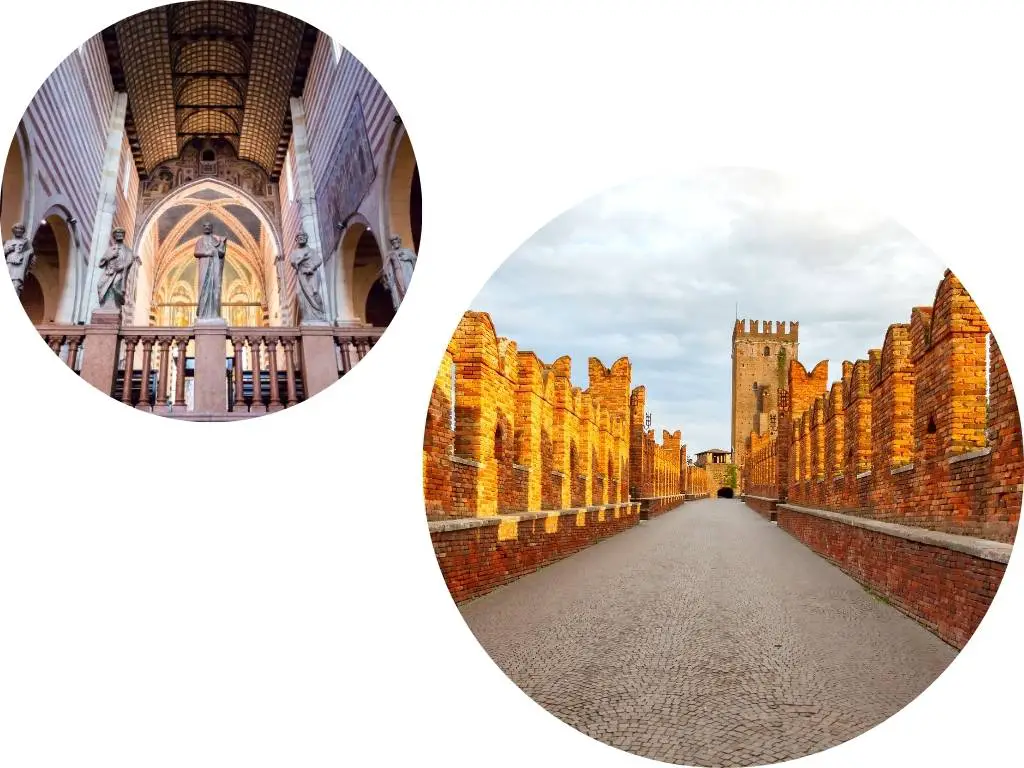
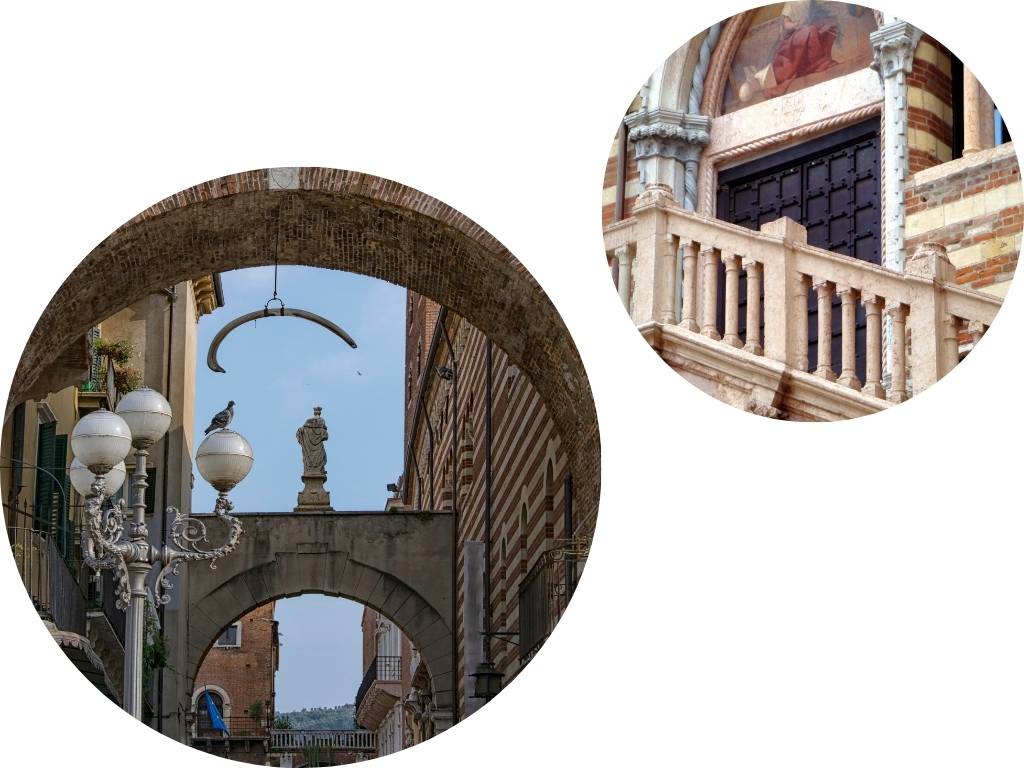
Verona’s scenic splendor is abundant, where Gothic and Medieval architecture graces the cityscape with charming red brick houses.
St. Peter’s hill beckons with its awe-inspiring panoramas, just a stone’s throw from the city center. The Scaligero Bridge, also known as Castelvecchio Bridge, links the western shore of the Adige to Castelvecchio, inviting a leisurely, romantic stroll amidst the hues of a captivating sunset. Surely, you would like their appearances preserved in your camera!
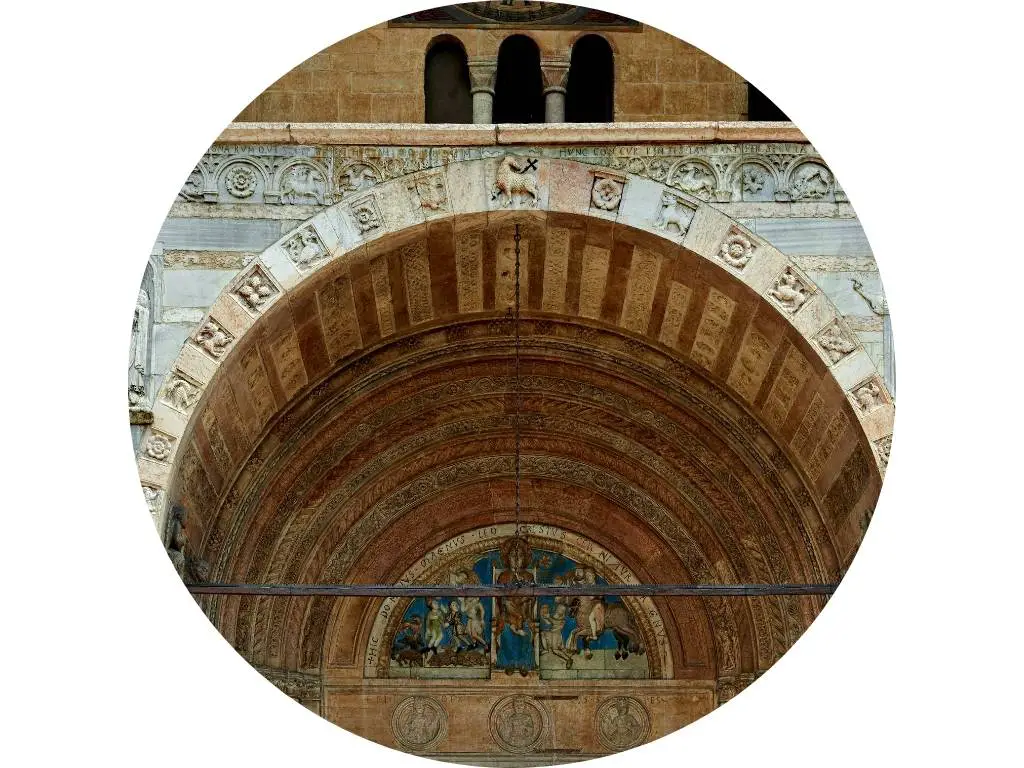
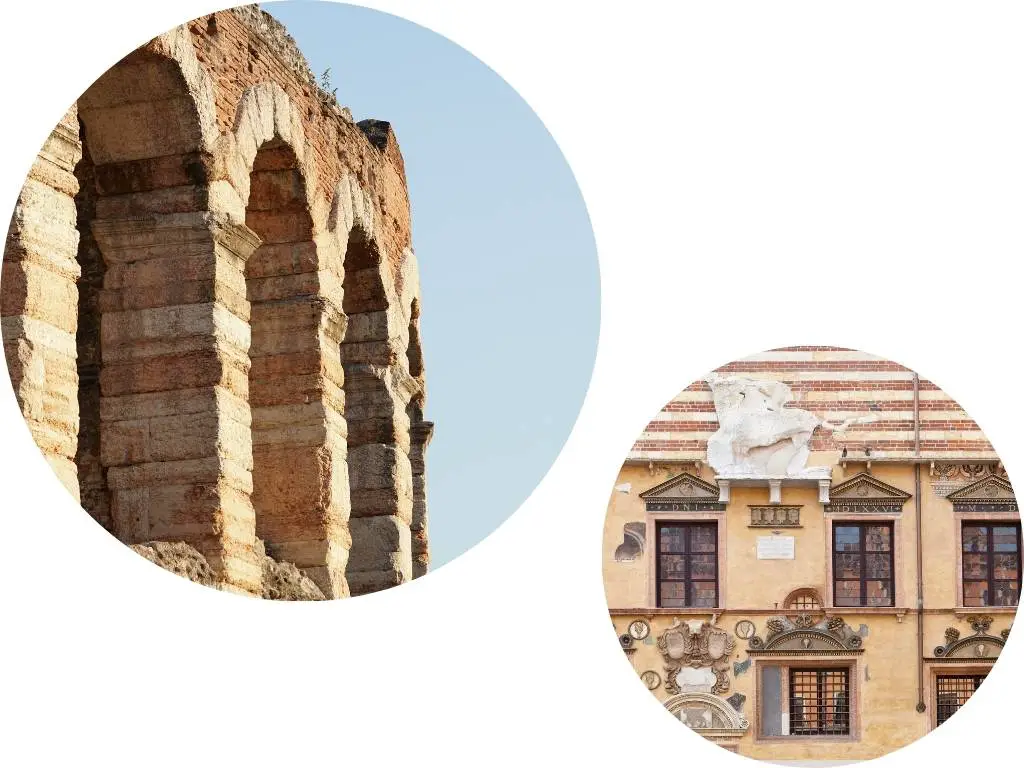
The golden hour in Verona is pure magic, casting a warm, ethereal glow over the city’s red roofs and historic edifices, setting the stage for captivating photographs. Viewing Verona during this enchanting time, whether from the vantage point of Torre dei Lamberti or St. Peter’s hill, promises an unforgettable experience.
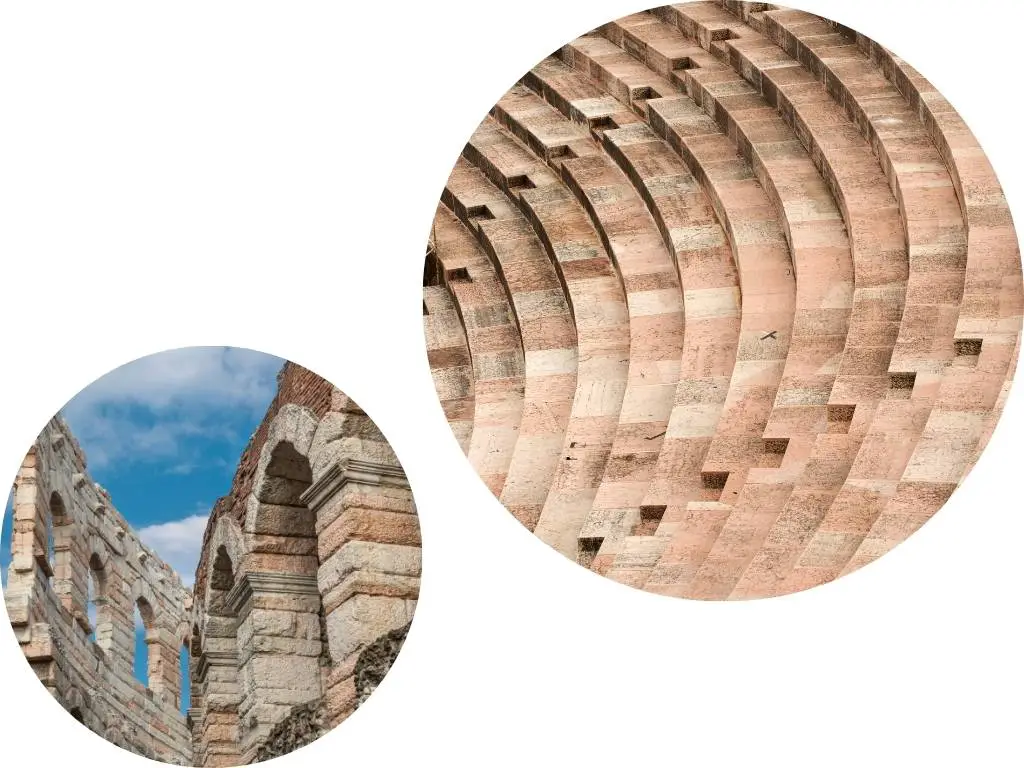
12. More Other Things to Do in Verona
Verona, a city teeming with activities, is yet another reason to make Italy your next travel destination. And what I’ve shown you is just the half of it (perhaps)! With every new place you discover and experience you gain, your interest will only grow.
Be sure to check out my handpicked collection of thrilling day tours, experiences, as well as passes and tickets.
See the complete list of the best things to do in Verona here.
Should you find yourself questioning what other adventures await in Northern Italy apart from Verona, or seeking suggestions for your journey after Verona, I have the following recommendations:
- Cinque Terre – The charming coastline towns of Northern Italy.
- Milan – Home to the genius’ (Leonardo da Vinci) artworks and science.
- Bergamo – The scenic and medieval city of northern Italy.
- Lake Como – One of the world’s most beautiful lakes.
- Venice – Another romantic city where three architectural styles meet and mix.
- Trento – The city to introduce you to the Dolomites (visit mountains, lakes, and castles).
- Bolzano – Home of Otzi, the gateway to the Dolomites.
- Cortina d’Ampezzo – The town in the heart of the Dolomites.
- Florence – It’s where you can find the best Renaissance artworks.
- Rome – The beautiful eternal city where you can start or end your trip to Northern Italy.
Best Time to Visit Verona
The ideal time for your Verona adventure really depends on what you’re hoping to get out of your visit. Let’s take a moment to explore the different factors that could shape your experience.
Consider the Temperature and Rain
Spring (March to May): Spring breathes life back into Verona after the winter. The city starts to warm up with temperatures ranging from a cool 9.3°C in March to a more comfortable 18.3°C in May. Rain may come frequent in May as summer approaches.
Summer (June to August): Summer is when Verona truly shines. The days are long, hot, and filled with sunlight. Temperatures peak at 24.7°C in July, making it perfect for exploring the city’s outdoor attractions. But remember to carry an umbrella as June and July are also the wettest months.
Autumn (September to November): As summer fades, autumn paints Verona in beautiful hues of orange and yellow. The weather cools down gradually from 19.8°C in September to a chilly 8.6°C in November. Rainfall is less frequent, making it a great time to explore without getting wet.
Winter (December to February): Winter wraps Verona in a cold embrace with temperatures dropping to -0.7°C in January. Despite the cold, there’s a certain charm to the city covered in frost. And with February being the driest month, you might get lucky with some sunny winter days.
Consider the Budget
If you’re mindful of your budget, consider planning your trip to Verona in November. This is when the city isn’t teeming with tourists, and as a result, hotel prices take a dip.
On the flip side, the summer months from June to August see a surge in visitors. This is the peak season, and as you might expect, the costs for hotels and flights go up.
Just to give you a ballpark figure, a night’s stay at a mid-range hotel during the peak season can set you back around $144.00. But if you choose to visit during the low season, you might find the same room for almost half the price at $72.00.
Remember, these are just average prices, and they can fluctuate. So, it’s always a good idea to check the current rates closer to your trip.
Consider the Experience
Avoiding the Crowds — If you’re looking to escape the crowds, consider visiting Verona in late spring or early autumn. These periods are typically less busy compared to the bustling summer months of July and August.
Sunlight and Rain — For those perfect sunny photos, July is your best bet as it’s the month with the most sunlight. However, keep in mind that May, June, and July are also the rainiest months, so don’t forget your umbrella!
First Impressions — Verona is a city that leaves a lasting impression any time of the year. However, if you want to avoid long lines at attractions and crowded restaurants, it might be best to steer clear of the peak summer months. The city can get quite packed with tourists during this time (long queues especially in Verona Arena).
Consider Cultural Events
Experiencing cultural events can add a unique flavor to your visit. In the charming city of Verona, there are three events that I believe would pique your interest.
- Verona Opera Festival: Imagine watching a grand opera under the stars in the city’s Roman Arena. That’s what you get at the Verona Opera Festival, which runs from June to September. It’s a magical experience that draws opera lovers from around the globe.
- Vinitaly: If you’re a wine enthusiast, Vinitaly is a must-visit. It’s the world’s largest wine exhibition, where you can learn about the art of wine-making and taste some of the finest wines. It’s not just for professionals in the wine industry, but for anyone who appreciates a good glass of wine.
- Estate Teatrale Veronese (Verona Summer Theatre Season): This is a summer theatre festival that runs from July to August. It’s not just about Shakespeare, although there’s plenty of that too. You’ll also get to enjoy concerts from various artists across different genres.
Discover more events from Verona’s calendar of events.
How Long to Spend in Verona
So, you’re planning a trip to Verona?
Great choice! Now, you might be wondering how many days to set aside for this charming Italian city. Well, it really depends on what kind of traveler you are.
Just want to catch the main attractions like the town center museums and those stunning vantage points? Then, a quick one to two-day trip should cover it. You can hit up the major spots like Piazza Bra, the Arena, and Juliet’s balcony all in a day. If you’ve got an extra day to spare, why not take it slow and soak in the city vibes?
But maybe you’re the type who wants to see it all — every nook and cranny, every hidden gem, and even sneak in a day trip to the gorgeous Lake Garda. If that’s you, then three days in Verona would be just about perfect. Spend two days getting lost in the city’s charm and save that third day for Lake Garda.
Remember though, these are just suggestions. Your trip is your own, so feel free to take it at your own pace.
Get more ideas: How Many Days to Spend in Verona: A Guide to Help You Decide
How to Get to Verona
When you’re flying into Verona, you’ll be landing at Verona Villafranca Airport (VRN), which is just a short 10 km hop from the city center. Once you’ve grabbed your luggage, you have a few options to reach the heart of Verona.
The quickest and most economical way is to catch a bus operated by Azienda Trasporti Verona Srl, which will whisk you to Verona Porta Nuova in about 15 minutes. If you prefer a more private ride, a taxi will get you there in roughly 20 minutes.
If you’re already in Italy and planning to visit Verona, it’s a breeze to get there from other major cities. Direct trains from Venice and Milan are frequent and convenient. And if you’re coming from further afield, flying into Verona’s airport is also an option.
Wondering if you need to rent a car in Verona? Well, it depends on your itinerary. If you’re sticking to the city center or planning to visit other major cities like Venice, Rome, or Milan, then public transportation or trains are your best bet. But if you’re thinking of exploring the countryside or regions like Tuscany, having a car could be handy.
Verona is not just about the city itself; it’s also an excellent base for exploring the region. You can easily do day trips to places like Lake Garda, Dolomites, Custoza, or Vicenza. Whether you need to rent a car for these trips really depends on your specific plans. But rest assured, many of these places are accessible via public transportation as well (aside from the Dolomites).
Where to Stay in Verona
Where should you stay? Let’s dive in!
First up, we have the Historic Center, also known as Città Antica.
It’s right in the heart of the city and is perfect if you want to be close to top attractions like Juliet’s House and the Roman Amphitheater. However, it can get a bit crowded and prices might be a tad higher due to its central location.
Next, there’s Porta Nuova. If you’re planning lots of day trips from Verona, this area is your best bet. It’s less crowded and conveniently located near the Stazione Verona Porta Nuova train station.
If you’re on a budget, consider staying in Veronetta. It’s a lively university district with affordable accommodation options and a buzzing nightlife. Just keep in mind that it can get a bit noisy due to student activities.
For those seeking peace and quiet, Borgo Trento is a great choice. It’s a residential neighborhood that’s ideal for families. However, dining and entertainment options might be limited compared to the city center.
Lastly, there’s San Zeno. It’s just outside of the historic center and offers a more authentic and peaceful experience of Verona.
In terms of budget-friendly areas, Veronetta takes the cake. It offers student-friendly prices and has many lovely coffee shops.
And if convenience is what you’re after, look no further than the Historic Center. It’s got everything – transportation, restaurants, and attractions!
Find the best hotel deals in Verona here.
Getting Around Verona
When you’re in Verona, you’ll find it’s a breeze to get around. The city has a fantastic public transportation system run by ATV, with buses that’ll take you all over the city and beyond. But if you’re in a hurry, there are always taxis waiting at the ranks throughout the city.
Fancy a bit of exercise? Why not rent a bike from Verona Bike and pedal your way around the city? And don’t forget, many of Verona’s must-see spots are just a short walk away from each other. So, lace up your walking shoes and explore at your own pace.
For a fun twist, you could even tour the city on a Segway! Now, if you’re thinking about venturing further out or want to dive deeper into what Verona and its surroundings have to offer, renting a car could be a good move.
Now, about that trip to Lake Garda — no worries, you won’t need to rent a car unless you want to. You can easily catch a train to Peschiera del Garda or Desenzano del Garda, two beautiful lakefront towns. If you prefer the scenic route, hop on a bus from Verona to Garda.
As for renting a car, it could come in handy if you’re planning to explore multiple locations around Lake Garda or other areas outside of Verona.
But when it comes to the old town of Verona itself, save yourself the hassle of parking and just go on foot. After all, the best way to soak up the charm of Verona’s old town is by strolling through its streets.
Save it on Pinterest.
